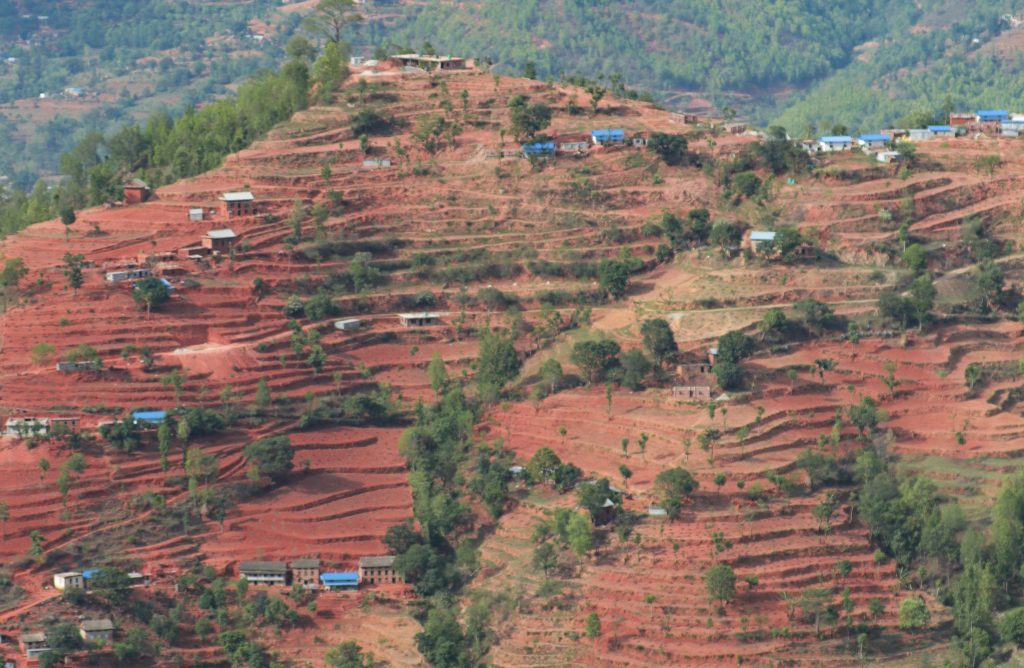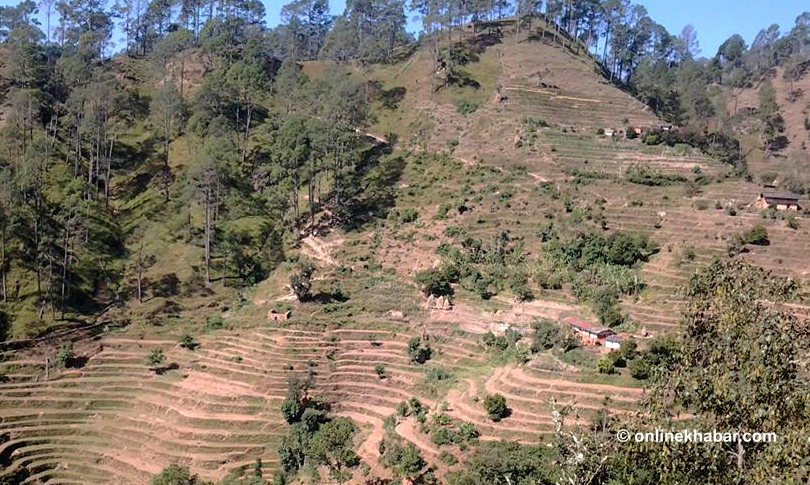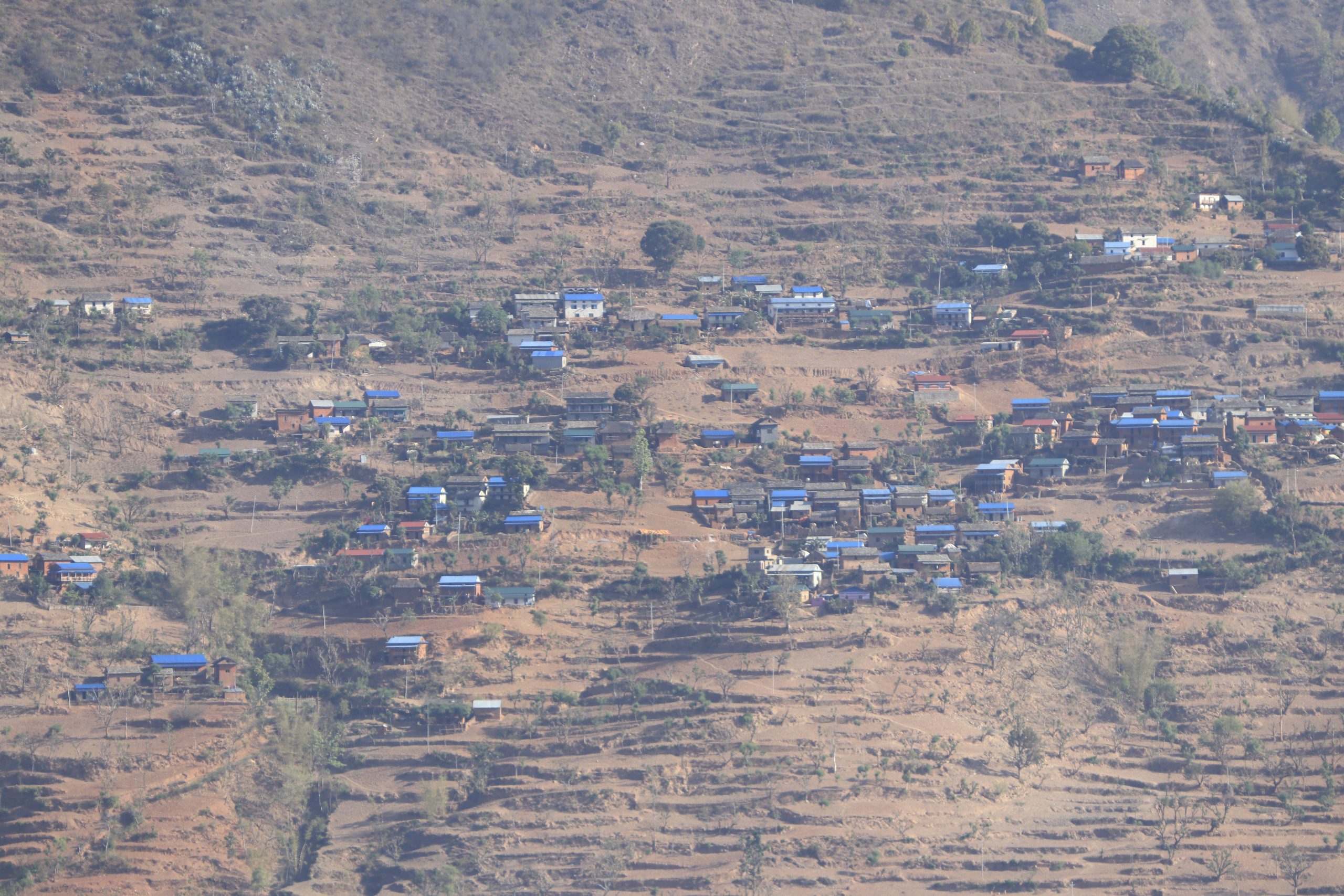Until seven years ago, Ramesh Kharel, a resident of Bhumlutar in the Kavrepalachok district in central Nepal would produce over 60 quintals of rice every year in his paddy field that is around 1.5 hectares. Half of his yields would suffice the need of the family; hence, he would sell the other half to the market so that he would get enough money to buy other daily consumables.
But, gradually, his paddy field began to wear a deserted look since the number of available people working in the village decreased. Several young men went abroad for lucrative jobs, and their wives began to live in cities such as Banepa and Dhulikhel so as to give better education to their children. All three sons of Kharel left home: one for foreign employment, the second for a government job, and the third for his education. His daughter-in-law began working in a bank in Panchkhal, an emerging town in the district.
With no personnel available in his family to work in the field, he got dependent on neighbours, but most of them were either too old or too young to work. Hence, he only cultivates only less than 20 per cent of his field today, and the amount of the production has dropped to 10 to 15 per cent. “I have to spend Rs 3,000 (approximately USD 25) a month to buy rice every month as I spend my days looking at this abandoned land,” Kharel laments.
Kharel, who once had emerged as a leading farmer in his village, says around half of the arable land in his village has been abandoned today because of the lack of human resources and wild boar attack among other reasons. Stakeholders say arable land abandonment in Nepal’s agricultural sector is so rampant that you do not need to refer to a scientific research report to support your claim. Whereas scholars think there are several measures to reclaim the abandoned land, the government officials state they have also taken some initiatives. However, thanks to the passivity of the actors, the problem is ever-increasing, threatening the natural ecosystem and food security in the country.
The gravity at the grassroots

Arable land abandonment is a common problem for all provinces of the country. Whereas this is not a big issue in southern plains, almost all hilly districts have a significant amount of arable land deserted, according to stakeholders.
Jagat Deuja, a land rights activist, estimates the amount of abandoned land in hilly districts is around 20 to 40 per cent in each. Ram Krishna Shrestha, the chief of the Centre for Crop Development and Agro Biodiversity Conservation under the Ministry of Agriculture, thinks it is at least 25 to 40 per cent in each district.
Besides the land pieces belonging to individuals, around 100,000 hectares of the arable land belonging to the government has been abandoned, according to Deuja. The amount of government land leased out to the public for agriculture is only nominal.
Nonetheless, no scientific study has taken place to measure the gravity of arable land abandonment at the national level. Consequently, Janak Raj Joshi, the spokesperson of the Ministry of Land Management, says the government does not have any detailed and accurate data about the problem.
A group of academic researchers had conducted a survey in three villages of Kavre, Kaski and Lamjung districts in 2019 to gauge the sensitivity of the arable land abandonment problem. It found 60 per cent of the farmers in the research sites have abandoned certain portions of their land whereas around 40 per cent of the total arable land in these areas has been abandoned. What troubled the researchers more is that 25 per cent of their sample reported an increase in the area of abandoned land in the past five years; the number of people saying they decreased the area was just five per cent.
The findings essentially do not mean that the problem is limited to just three districts. Saraswati Lohar, the president of the National Land Rights Forum, says her organisation has launched a project in selected places in the Sudurpaschim province to let landless people reclaim abandoned arable land, which proves this is a big issue in far-western Nepal.
The Land Management Ministry’s spokesperson Joshi says the government has also identified arable land abandonment as a problem. “Yes, this is a big problem and it has a long-term impact on Nepal’s society and economy,” Joshi says, “If we can sort it out, we can reduce unemployment, increase food supply and make our country independent in agriculture. We can also increase foreign exchange reserves by decreasing imports. We shall move ahead towards that end.”
Crucial causes

Krishna Prasad Paudel, who identifies himself as a ‘farming-for-food’ activist, says arable land abandonment was not a crucial problem until the 1980s. Until then, only the land where producing crops would be difficult due to physical terrain and lack of water would be abandoned. But, in the next decade, the country entered into a civil war, which chased many farmers away from their farms.
In the meantime, farming became more expensive. On the other hand, people also attained access to other sources of income along with education. Thanks to the availability of advanced fertilisers and seeds as well as technology, people became able to produce more in a small piece of land. All of these contributed to arable land abandonment.
“It is believed that around 25 per cent of farmers in Nepal do not have their own land, but the amount of arable land abandoned is way more than that ratio,” Paudel questions, “Isn’t it ironic?”
Shanti Nath Adhikari, a farmer from the Okhaldhunga district of eastern Nepal, agrees with Paudel. Adhikari, also active in encouraging farmers to recultivate abandoned land, says, “Whereas poor farmers do not have land, the rich have abandoned it to live in cities. When we ask them to rent out, they do not because they fear the rentee would acquire the land for free.”
Until the mid-1990s, there was a law in Nepal that granted the rentees partial ownership of the land, commonly known as mohiyani hak. However, it has already been 25 years since the law was repealed. Yet, landlords fear the system of dual ownership would come back thanks to political instability and differing views on land rights among political parties. But, Deuja says the problem of arable land abandonment existed as the government failed to assure landlords that they would not lose their ownership of the land even when they rent out the land for several decades.
“But, there is no assurance, hence landlords choose to abandon their land than to let someone else work there.”
Even those who rent out land set a contract for a short period such as a year and farmers are not interested, according to Deuja. “If you get the land, you should be allowed to cultivate it for at least three to five years,” Deuja says, “because the fertiliser you apply to one batch of crops will also work for the next; the farmers do not want to waste that.”
Moreover, the activist says the state’s failure to “protect” the “life-saving” sector has resulted in arable land abandonment. “You cannot sustain agriculture by calculating investments versus profit and loss; you always need grains and vegetables to save your life even if producing it meant a loss. Hence, agriculture should have been a social enterprise protected by the state, something more than a profession or business,” Deuja says, “But, the state did not protect the sector and its result is what you see today.”
Yuba Raj Subedi, one of the researchers involved in the 2019 survey, identifies major factors behind increasing arable land abandonment: lack of human resources due to labour migration, wildlife attack, declining productivity due to climate change and other factors, a lack of irrigation and fertilising facilities, and difficulties in accessing the market.
“Further, arable land is a big part of the parental inheritance in Nepal, and parents fragment it among their sons,” Subedi, who is currently pursuing a PhD in arable land abandonment in Nepal at the University in New England in Australia, says, “Then, you use land not for farming but for claiming your social status.”
Consequently, the average area of an arable land plot is ever-decreasing in Nepal. Ram Krishna Shrestha, the chief of Centre for Crop Development and Agro Biodiversity Conservation, informs the average area of an arable land plot was 0.8 hectares in 2001, which reduced to 0.68 in 2011. “This year, the new data will come out, and I fear it will be less than 0.6 hectares.”
‘Farming-for-food’ activist Paudel says the arable land abandonment increased due to the introduction of the so-called green revolution in Nepal. “Instead of farming according to the nature of our land, you imitated the foreign way,” he explains, “Then, you needed irrigation, chemical fertiliser, advanced seeds, pesticides and fossil fuel-dependent machines. It means the farmers are dependent on others for other requirements except for land. Consequently, they were not motivated to continue.”
On the other hand, the “revolution” increased the cost of farming, and it became another factor behind arable land abandonment, according to him.
Perhaps, that is why Shrestha says, “These days, people earn more by abandoning arable land than by cultivating it.”
Results and risks

Rights activist Jagat Deuja says the impact of arable land abandonment may not be visible immediately, but in the long run, it will be disastrous. “If the current situation persists, the national will face food insecurity,” he says, “And, when people do not have enough to eat, there will be even worse social consequences.”
Shrestha also paints a similar picture. “When the soil’s fertility is lost, you cannot take it back. You can, but it is super difficult,” he says, “On the other hand, there is no guarantee that you will always have money enough to buy your food. Even, the food that you have been buying might not be available in the market. You have already experienced this during the 2015 border blockade.”
Many of the families that were dependent on agriculture have found their income in foreign employment today, but that is not sustainable, Shrestha warns. “You know remittance is just like a bubble of water that may burst anytime. Recently, Covid-19 had nearly burst that bubble.”
Agroforestry expert Bishnu Hari Pandit also agrees with Shrestha. He says people do not have a right to talk about employment, productivity and economic reform when arable land abandonment is so much rampant. “In the context of Nepal, no economic activity is as sustainable as agriculture in Nepal.
The impact of climate change on agriculture will be harsher when arable land abandonment increases, according to Shrestha. “Invasive plants will rule the abandoned land. Existing biodiversity will be lost. Soil erosion will get worse,” he says, “If we do not act today, there will not be an alternative to regretting tomorrow.”
Search for solutions
What Shrestha means is action today is imperative to solve, or at least delay, ongoing arable land abandonment. Farmers and stakeholders say a gradual solution is possible, but governments at the federal and local levels should be responsible.
Okhaldhunga-based farmer Shanti Nath Adhikari says in his area, farmers are making efforts to recultivate the land they abandoned because of attacks from monkeys. Locals have planted crops such as turmeric, lemon, and cardamom that the monkeys do not like. “Moreover, local governments have big funds for agriculture these days. If you have someone in the village who can write proposals and negotiate with the officials, you can get that money for a project,” an exciting Adhikari says.

As Adhikari suggests, agroforestry campaigner Bishnu Hari Pandit has launched a project in his birthplace, Ratanpur of Tanahun, in response to arable land abandonment. The project funded by Ithaka Institute has planted 62,000 plants in the abandoned land in the past five years, according to him. “Whereas many farmers have already benefitted, more are getting benefits in the next few years.”
Recently, the project has been expanded outside Ratanpur as it is in operation in the four local units of Tanahun and Lamjung districts. While concerned local governments have extended their support, the Gandaki provincial government is also interested to assist in non-government efforts against arable land abandonment, claims Pandit.
Farmers associated with the project say they will continue efforts to reclaim the abandoned land even if the project ends. For this, locals of Ratanpur have established a cooperative. The cooperative’s chairman Dolnath Dhakal says, “If they leave, we will search for our own way to the market.”
Ram Krishna Shrestha, the chief of the Centre for Crop Development and Agro Biodiversity Conservation, says there are several measures that locals can take to mitigate efforts of arable land abandonment. He also assures the government provides assistance to them in different forms. “For example, our office will give you Rs 900 (approximately USD 7.5) a year for each ropani (0.05 hectare) if you cultivate some native species in the abandoned land.”
Moreover, the federal government should establish a powerful body to address increasing arable land abandonment ensuring the representation of officials of all three tiers of the government, he suggests.
All stakeholders agree local governments should take a lead in responding to the problem as the constitution has defined agriculture as their jurisdiction.
Meanwhile, Janak Raj Joshi, the spokesperson at the Ministry of Land Management, says the government is introducing a new regulation to implement the provision of the land bank as mentioned in the new Land Use Act, 2019, saying it will effectively discourage arable land abandonment.
While Joshi claims the government is in the final step of preparation to issue the new rule, rights activist Jagat Deuja sees different interest groups blocking the way.
Nonetheless, he agrees an effective implementation of the Land Use Act, 2019, will significantly reduce arable land abandonment in the country.
So, if the local governments and the farmers, in general, are ready to adopt the solutions is the question that is yet to be answered.


























